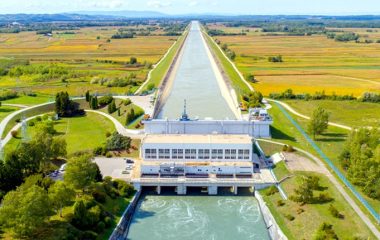
Photo: GEN Energija
The optimal capacity of the new nuclear unit Krško 2, regarding grid impact, is estimated at up to 1,300 MW, while for 1,000 MW the investment is estimated at EUR 9.3 billion.
The figures are from the studies on grid connection and investment valuation for the Krško 2 nuclear power plant project (JEK 2). Energy company GEN Energija presented them.
It revealed that it sent a draft proposal to the government to start spatial planning on a national level for the construction of the facility.
The project is widely discussed in Slovenia, and its prospects will be revealed after citizens vote in a referendum. GEN Energija said it would open an information office in the building of the Municipality of Krško in June and organize a roadshow in several cities.
Aleksandar Momirovski from the Milan Vidmar Electrical Institute (Elektroinštitut Milan Vidmar) presented the study on the grid connection of power plants with a capacity ranging from 1,000 MW to 2,400 MW. The authors examined the electricity system’s safety and stability.
The price of electricity ranges from EUR 66 to EUR 144 per MWh
Regarding the safety and stability of the system, the optimal size of JEK 2 is up to 1,300 MW, said Momirovski.
He stressed the new generation unit would require balancing services.
GEN Energija Chief Financial Officer Kruno Abramovič presented the investment cost assessment. Based on the data collected so far, which are not based on binding offers from potential suppliers of equipment and services, a 1,000 MW power plant would cost EUR 9.3 billion, and EUR 15.4 billion is the price for a 1,650 MW plant, he said.
The company stressed that the calculation doesn’t include financing costs and announced it would hire a third party to audit the report. The result will be presented before the referendum, it added.
The price of electricity from the nuclear power plant, depending on the financing costs, should range from EUR 66 to 144 per MWh.
Gen Energija’s Paravan: Government’s role in financing is highly important
According to the company, the financial structure and sources of financing will be known and determined before the final investment decision is made. It expects to adopt it in 2028.
The cost of financing will have a big impact on the project, so the government’s role is very important, CEO Dejan Paravan underscored.
GEN Energija said the Krško 2 nuclear power plant should ensure a stable supply of electricity for at least 60 years, or 80 years or more in the case of an extension of its lifespan. The investment, as announced, should create 5,640 new jobs in 10 years, GEN Energija said.




















Be the first one to comment on this article.